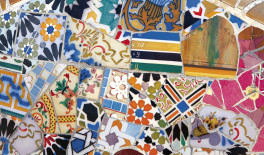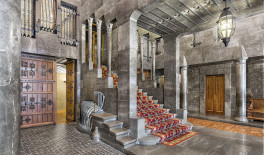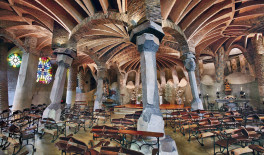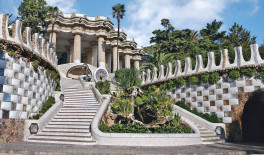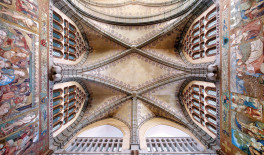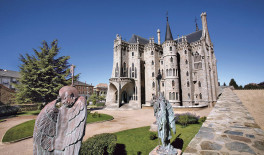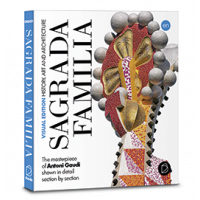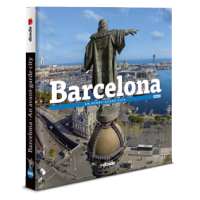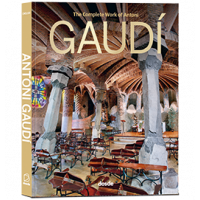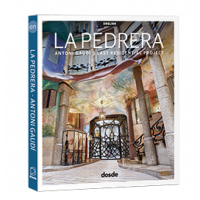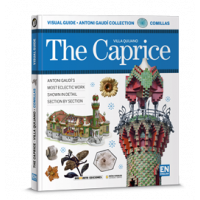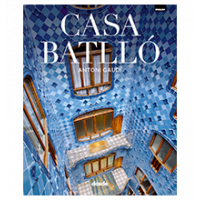Antoni Gaudí
Visual Edition, The Definitive Complete Work
RETURN
About the book The complete Work of Gaudí
Provided with an overflowing imagination and an amazing ability to discover new technical solutions, Antoni Gaudí is considered to be one of the most influential architects of all time. His extense artistic legacy is admired today by fans and experts from all around the world and it also is the main testimony of the incredible genius of an inimitable creator.
In each one of his works, Gaudí provided revolutionary ideas that brought innovative structural and functional solutions that have been universally used over time. The Basilica of the Sagrada Familia, Casa Batlló, La Pedrera, Park Güell, the Caprice, Casa Vicens, the Episcopal Palace of Astorga and the Torre Bellesguard are some of the Catalan architect's most emblematic projects, who also developed his creativity in areas such as furniture design, the creation of models for sculptures, ornamentation and landscaping.
This book compiles all Gaudí's works, showing the evolution of the architect, one of the greatest exponents of Modernisme. Through this book published by Dosde, the reader will discover how Gaudí developed his style, dispensing with external influences in order to create works that were more and more original and which converted into icons of an incomparable artist.
In each one of his works, Gaudí provided revolutionary ideas that brought innovative structural and functional solutions that have been universally used over time. The Basilica of the Sagrada Familia, Casa Batlló, La Pedrera, Park Güell, the Caprice, Casa Vicens, the Episcopal Palace of Astorga and the Torre Bellesguard are some of the Catalan architect's most emblematic projects, who also developed his creativity in areas such as furniture design, the creation of models for sculptures, ornamentation and landscaping.
This book compiles all Gaudí's works, showing the evolution of the architect, one of the greatest exponents of Modernisme. Through this book published by Dosde, the reader will discover how Gaudí developed his style, dispensing with external influences in order to create works that were more and more original and which converted into icons of an incomparable artist.
Visual Edition
Antoni Gaudí
Incluye contenido digital exclusivo
Hecho con papel que respeta el medio ambiente
Multilenguaje: Publicado en 9 idiomas
Más de 700 fotografías e ilustraciones 3D
About the book The complete Work of Gaudí
Provided with an overflowing imagination and an amazing ability to discover new technical solutions, Antoni Gaudí is considered to be one of the most influential architects of all time. His extense artistic legacy is admired today by fans and experts from all around the world and it also is the main testimony of the incredible genius of an inimitable creator.
In each one of his works, Gaudí provided revolutionary ideas that brought innovative structural and functional solutions that have been universally used over time. The Basilica of the Sagrada Familia, Casa Batlló, La Pedrera, Park Güell, the Caprice, Casa Vicens, the Episcopal Palace of Astorga and the Torre Bellesguard are some of the Catalan architect's most emblematic projects, who also developed his creativity in areas such as furniture design, the creation of models for sculptures, ornamentation and landscaping.
This book compiles all Gaudí's works, showing the evolution of the architect, one of the greatest exponents of Modernisme. Through this book published by Dosde, the reader will discover how Gaudí developed his style, dispensing with external influences in order to create works that were more and more original and which converted into icons of an incomparable artist.
In each one of his works, Gaudí provided revolutionary ideas that brought innovative structural and functional solutions that have been universally used over time. The Basilica of the Sagrada Familia, Casa Batlló, La Pedrera, Park Güell, the Caprice, Casa Vicens, the Episcopal Palace of Astorga and the Torre Bellesguard are some of the Catalan architect's most emblematic projects, who also developed his creativity in areas such as furniture design, the creation of models for sculptures, ornamentation and landscaping.
This book compiles all Gaudí's works, showing the evolution of the architect, one of the greatest exponents of Modernisme. Through this book published by Dosde, the reader will discover how Gaudí developed his style, dispensing with external influences in order to create works that were more and more original and which converted into icons of an incomparable artist.
No reviews yet.
Additional Information
- Additional Information
- Subtitle: Visual Edition, The Definitive Complete Work
- Weight (g): 666
- Binding: Paperback with flaps
- Size (cm): 17,5 x 19,5
- Author: Dosde
- Pages: 240
- Edition: Visual Edition
Gaudí's works
Born in Reus, Gaudí moved to Barcelona in his adolescence to complete his studies, where he also embarked on his architecture degree. This city was where the majority of his works were carried out and which converted him into a reputable architect.
Antoni Gaudí already showed off his genius in his early works in Barcelona, such as the case of Casa Vicens and Palau Güell. Between the end of the 19th century and the start of the 20th century, when he was already a recognised professional, he planned works such as the Teresian College, Casa Vicens and Torre Bellesguard.
It was in his mature period that we find Gaudí's most important works in Barcelona, which include Casa Batlló, La Pedrera and Park Güell. Following these projects, now converted into icons of Barcelona and Spanish Modernist architecture, Gaudí focused on the construction of Sagrada Familia, to which he dedicated 43 years of his life, almost his entire career, his most prestigious and complex project, in which he incorporated all the structural and symbolic resources that he had developed since the start of his professional career.
One of his first architectonic projects was, precisely, the bleaching room of the Workers’ Cooperative of Mataró (1878), where he already used parabolic arches to define a very large space. Four years later, in 1882, he designed some hunting lodges for Eusebi Güell on the site where the Güell Wine Cellars would be later built.
The list of lesser known works by Gaudí is completed with the gate of Finca Miralles, the Catllaràs chalet and the Schoolrooms of the Sagrada Familia, buildings that can still be visited. However, other projects such as the Torre de La Miranda, the Arab room in the Bar Torino or the lamp posts in the Plaza Mayor in Vic, disappeared with the passage of time.
Antoni Gaudí already showed off his genius in his early works in Barcelona, such as the case of Casa Vicens and Palau Güell. Between the end of the 19th century and the start of the 20th century, when he was already a recognised professional, he planned works such as the Teresian College, Casa Vicens and Torre Bellesguard.
It was in his mature period that we find Gaudí's most important works in Barcelona, which include Casa Batlló, La Pedrera and Park Güell. Following these projects, now converted into icons of Barcelona and Spanish Modernist architecture, Gaudí focused on the construction of Sagrada Familia, to which he dedicated 43 years of his life, almost his entire career, his most prestigious and complex project, in which he incorporated all the structural and symbolic resources that he had developed since the start of his professional career.
Gaudí's lesser known works
The brilliance of architect Antoni Gaudí’s major works overshadows the rest of the many constructions, designs and missing or unexecuted projects that he produced over the length of his prolific career. The more than 90 projects that Antoni Gaudí is known for demonstrate the artist’s versatility, who often went beyond his vocation as architect in order to get involved in the design of furniture, the decoration of interiors, the adornment of religious spaces, the planning of gardens…One of his first architectonic projects was, precisely, the bleaching room of the Workers’ Cooperative of Mataró (1878), where he already used parabolic arches to define a very large space. Four years later, in 1882, he designed some hunting lodges for Eusebi Güell on the site where the Güell Wine Cellars would be later built.
The list of lesser known works by Gaudí is completed with the gate of Finca Miralles, the Catllaràs chalet and the Schoolrooms of the Sagrada Familia, buildings that can still be visited. However, other projects such as the Torre de La Miranda, the Arab room in the Bar Torino or the lamp posts in the Plaza Mayor in Vic, disappeared with the passage of time.

